Anguilla
| Anguilla |
||||||
|---|---|---|---|---|---|---|
|
||||||
| Motto: "Strength and Endurance" | ||||||
Anthem:
|
||||||
.svg.png) |
||||||
_-_AIA_-_UNOCHA.svg.png) |
||||||
| Status | British Overseas Territory | |||||
| Capital and largest city | The Valley | |||||
| Official languages | English | |||||
| Ethnic groups ([1]) |
|
|||||
| Demonym | Anguillian | |||||
| Government | Parliamentary dependency under a constitutional monarchy | |||||
| - | Monarch | Elizabeth II | ||||
| - | Governor | Christina Scott | ||||
| - | Deputy Governor | Stanley Reid | ||||
| - | Chief Minister | Victor Banks | ||||
| - | Responsible Ministerb (UK) | Mark Simmonds MP | ||||
| Legislature | House of Assembly | |||||
| Establishment | ||||||
| - | Overseas territory | 1980 | ||||
| Area | ||||||
| - | Total | 91 km2 (220th) 35 sq mi |
||||
| - | Water (%) | negligible | ||||
| Population | ||||||
| - | 2006 estimate | 13,600[2] (215th) | ||||
| - | 2011 census | 13,452 | ||||
| - | Density | 132/km2 (n/a) 342/sq mi |
||||
| GDP (PPP) | 2004 estimate | |||||
| - | Total | $108.9 million | ||||
| - | Per capita | $8,800 | ||||
| Currency | East Caribbean dollar (XCD) | |||||
| Time zone | (UTC-4) | |||||
| Drives on the | left | |||||
| Calling code | +1-264 | |||||
| ISO 3166 code | AI | |||||
| Internet TLD | .ai | |||||
| a. | "National Song of Anguilla". Official Website of the Government of Anguilla. Archived from the original on 23 July 2011. Retrieved 10 July 2011. | |||||
| b. | For the Overseas Territories. UK Postcode: AI-2640 |
|||||
Anguilla (/æŋˈɡwɪlə/ ang-GWIL-ə) is a British overseas territory in the Caribbean.[3] It is one of the most northerly of the Leeward Islands in the Lesser Antilles, lying east of Puerto Rico and the Virgin Islands and directly north of Saint Martin. The territory consists of the main island of Anguilla itself, approximately 16 miles (26 km) long by 3 miles (5 km) wide at its widest point, together with a number of much smaller islands and cays with no permanent population. The island's capital is The Valley. The total land area of the territory is 35 square miles (90 km2),[4] with a population of approximately 13,500 (2006 estimate).
Anguilla has become a popular tax haven, having no capital gains, estate, profit or other forms of direct taxation on either individuals or corporations.[5] In April 2011, faced with a mounting deficit, it introduced a 3% "Interim Stabilisation Levy", Anguilla's first form of income tax.[6]
Etymology
The name Anguilla derives from the word for "eel" in any of various Romance languages (modern Spanish: anguila; French: anguille; Italian: anguilla; Portuguese: enguia; Romanian anghilă; Catalan: anguila; Galician: anguía [7]), probably chosen because of the island's eel-like shape.
History
Anguilla was first settled by Amerindian tribes who migrated from South America. The earliest Native American artefacts found on Anguilla have been dated to around 1300 BC, and remains of settlements date from 600 AD.[8] The date of European discovery is uncertain: some sources claim that Columbus sighted the island in 1493, while others state that the island was first discovered by the French in 1564 or 1565.[9]
Anguilla was first colonised by English settlers from Saint Kitts, beginning in 1650.[10] The French temporarily took over the island in 1666 but under the Treaty of Breda it was returned to English control. In this early colonial period Anguilla sometimes served as a place of refuge. A Major John Scott who visited in September 1667 wrote of leaving the island "in good condition" and noted that in July 1668 "200 or 300 people fled thither in time of war."[11] Other early arrivals included Europeans from Antigua & Barbuda and Barbados.
It is likely that some of these early Europeans brought enslaved Africans with them. Historians confirm that African slaves lived in the region in the early 17th century. For example, Africans from Senegal lived in St. Christopher (today St. Kitts) in 1626. By 1672 a slave depot existed on the island of Nevis, serving the Leeward Islands. While the time of African arrival in Anguilla is difficult to place precisely, archival evidence indicates a substantial African presence (at least 100) on the island by 1683.
While traditional histories of the region assume that the English were the first settlers of Anguilla under British rule, recent scholarship focused on Anguilla offers a different view. It places more significance on early sociocultural diversity. The research suggested that St. Christopher,[12] Barbados, Nevis and Antigua may have been important points of origin. Regarding African origins, West Africa as well as Central Africa are both posited as the ancestral homelands of some of Anguilla's early African population.[13]
During the early colonial period, Anguilla was administered by the British through Antigua, but in 1824 it was placed under the administrative control of nearby Saint Kitts. In 1967, Britain granted Saint Kitts and Nevis full internal autonomy, and Anguilla was also incorporated into the new unified dependency, named Saint Christopher-Nevis-Anguilla, against the wishes of many Anguillians. This led to two rebellions in 1967 and 1969 (Anguillian Revolution), headed by Ronald Webster, and a brief period as a self-declared independent republic. The goal of the revolution was not independence per se, but rather independence from Saint Kitts and Nevis, and a return to being a British colony. British authority was fully restored in July 1971, and in 1980 Anguilla was finally allowed to secede from Saint Kitts and Nevis and become a separate British Crown colony (now a British overseas territory).[3]
Governance

Political system
Anguilla is an internally self-governing overseas territory of the United Kingdom. Its politics take place in a framework of a parliamentary representative democratic dependency, whereby the Chief Minister is the head of government, and of a pluriform multi-party system.
The United Nations Committee on Decolonization includes Anguilla on the United Nations list of Non-Self-Governing Territories. The territory's constitution is Anguilla Constitutional Order 1 April 1982 (amended 1990). Executive power is exercised by the government. Legislative power is vested in both the government and the House of Assembly. The Judiciary is independent of the executive and the legislature.
Defence
Anguilla being a dependency of the UK, the UK is responsible for its military defence, although there are no active garrison or armed forces present. Anguilla has a small marine police force comprising around 32 personnel which operates one M160-class fast patrol boat
Geography

Anguilla is a flat, low-lying island of coral and limestone in the Caribbean Sea, east of Puerto Rico and the Virgin Islands. It is directly north of Saint Martin, separated from that island by the Anguilla Channel. The soil is generally thin and poor, supporting scrub tropical and forest vegetation.
Anguilla is noted for its spectacular and ecologically important coral reefs and beaches. Apart from the main island of Anguilla itself, the territory includes a number of other smaller islands and cays, mostly tiny and uninhabited. Some of these are:
- Anguillita
- Dog Island
- Prickly Pear Cays
- Sandy Island
- Scrub Island
- Scilly Cay
- Seal Island
- Sombrero, also known as Hat Island
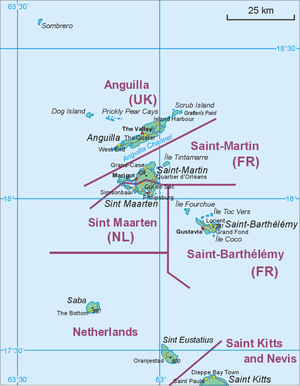 Map showing location of Anguilla relative to Sint Maarten/Saint Martin and other islands to its south |
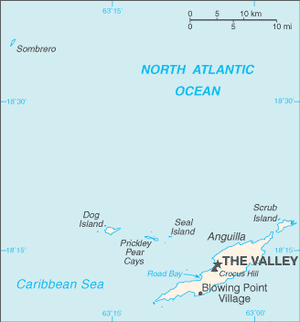 Map of Anguilla |
Climate
Temperature
Northeastern trade winds keep this tropical island relatively cool and dry. Average annual temperature is 80 °F (27 °C).[4] July–October is its hottest period, December–February, its coolest.
Rainfall
Rainfall averages 35 inches (890 mm) annually,[4] although the figures vary from season to season and year to year. The island is subject to both sudden tropical storms and hurricanes, which occur in the period from July to November. The island suffered damage in 1995 from Hurricane Luis and severe flooding 5–20 feet from Hurricane Lenny.
Economy

Anguilla's thin arid soil is largely unsuitable for agriculture, and the island has few land-based natural resources. Its main industries are tourism, offshore incorporation and management, offshore banking, captive insurance and fishing.
Before the 2008 world-wide crisis the economy of Anguilla was expanding rapidly, especially the tourism sector which was driving major new developments in partnerships with multi-national companies.
Anguilla's currency is the East Caribbean dollar, though the US dollar is also widely accepted. The exchange rate is fixed to the US dollar at US$1 = EC$2.70.
The economy, and especially the tourism sector, suffered a setback in late 1995 due to the effects of Hurricane Luis in September but recovered in 1996. Hotels were hit particularly hard during this time. Another economic setback occurred during the aftermath of Hurricane Lenny in 2000.[14]
Anguilla's financial system comprises 7 banks,[15] 2 money services businesses, more than 40 company managers, more than 50 insurers, 12 brokers, more than 250 captive intermediaries, more than 50 mutual funds, 8 trust companies.[16]
Anguilla aims to obtain 15% of its energy from solar power so it is less reliant on expensive imported diesel. The Climate & Development Knowledge Network is helping the government gather the information it needs to change the territory's legislation, so it can integrate renewables into its grid. Barbados, have also made good progress in switching to renewables, but many other SIDS are still at the early stages of planning how to integrate renewable energy into their grids. “For a small island we’re very far ahead,” said Beth Barry, Coordinator of the Anguilla Renewable Energy Office. "We’ve got an Energy Policy and a draft Climate Change policy and have been focussing efforts on the question of sustainable energy supply for several years now. As a result we have a lot of information we can share with other islands.”[17]
Transportation
Air
Anguilla is served by Clayton J. Lloyd International Airport (prior to 4 July 2010 known as Wallblake Airport). The primary runway at the airport is 5,462 feet (1,665 m) in length and can accommodate moderate-sized aircraft. Services connect to various other Caribbean islands via regional carrier LIAT, local charter airlines and others. Although there are no direct scheduled flights to or from continental America or Europe, Tradewind Aviation and Cape Air provide scheduled air service to San Juan, Puerto Rico. The airport can handle large narrow-body jets such as the Boeing 727, Boeing 737 and Boeing 757.
Road
Aside from taxis, there is no public transport on the island. Cars drive on the left.
Boat

There are regular ferries from Saint Martin to Anguilla. It is a 20-minute crossing from Marigot, St. Martin to Blowing Point, Anguilla. Ferries commence service from 7:00 am. There is also a Charter Service, from Blowing Point, Anguilla to Princess Juliana Airport to make travel easier. This way of travel is the most common method of transport between Anguilla and St. Martin or St. Maarten.
Demographics
The majority of residents (90.08%) are black, the descendants of slaves transported from Africa. Growing minorities include whites at 3.74% and people of mixed race at 4.65% (figures from 2001 census).
72% of the population is Anguillian while 28% is non-Anguillian (2001 census). Of the non-Anguillian population, many are citizens of the United States, United Kingdom, St Kitts & Nevis, the Dominican Republic, Jamaica and Nigeria.
2006 and 2007 saw an influx of large numbers of Chinese, Indian, and Mexican workers, brought in as labour for major tourist developments due to the local population not being large enough to support the labour requirements.
Culture


The Anguilla National Trust (ANT) was established in 1988 and opened its offices in 1993 charged with the responsibility of preserving the heritage of the island, including its cultural heritage. The Trust has programmes encouraging Anguillian writers and the preservation of the island's history.
The island's cultural history begins with the Taino Indians. Artifacts have been found around the island, telling of life before European settlers arrived.
As throughout the Caribbean, holidays are a cultural fixture. Anguilla's most important holidays are of historic as much as cultural importance – particularly the anniversary of the emancipation (previously August Monday in the Park), celebrated as the Summer Festival. British festivities, such as the Queen's birthday, are also celebrated.
Cuisine
Anguillian cuisine is influenced by native Caribbean, African, Spanish, French and English cuisines.[18] Seafood is abundant, and includes prawns, shrimp, crab, spiny lobster, conch, mahi-mahi, red snapper, marlin and grouper.[18] Salt cod is a staple food eaten by itself and used in stews, casseroles and soups.[18] Livestock is limited due to the small size of the island, and people there utilise poultry, pork, goat and mutton, along with imported beef.[18] Goat is the most commonly eaten meat, and is utilised in a variety of dishes.[18]
A significant amount of the island's produce is imported due to limited land suitable for agriculture production; much of the soil is sandy and infertile.[18] Among the agriculture produced in Anguilla includes tomatoes, peppers, limes and other citrus fruits, onion, garlic, squash, pigeon peas and callaloo. Starch staple foods include imported rice and other foods that are imported or locally grown, including yams,[19] sweet potatoes[19] and breadfruit.[18]
Language

Today most people in Anguilla speak a British-influenced variety of "Standard" English. Other languages are also spoken on the island, including varieties of Spanish, Chinese and the languages of other immigrants. However, the most common language other than Standard English is the island's own English-lexifier Creole language (not to be confused with French Creole spoken in islands such as Haiti, Martinique, and Guadeloupe). It is referred to locally by terms such as "dialect" (pronounced "dialek"), Anguilla Talk, or "Anguillian". It has its main roots in early varieties of English and West African languages, and is similar to the dialects spoken in English-speaking islands throughout the Eastern Caribbean, in terms of its structural features and to the extent of being considered one single language.[20]
Linguists who are interested in the origins of Anguillian and other Caribbean Creoles point out that some of its grammatical features can be traced to African languages while others can be traced to European languages. Three areas have been identified as significant for the identification of the linguistic origins of those forced migrants who arrived before 1710: the Gold Coast, the Slave Coast, and the Windward Coast.[21]
Sociohistorical information from Anguilla's archives suggest that Africans and Europeans formed two distinct, but perhaps overlapping speech communities in the early phases of the island's colonisation. "Anguillian" is believed to have emerged as the language of the masses as time passed, slavery was abolished, and locals began to see themselves as "belonging" to Anguillian society.[13]
Music
Religion
Religion is another aspect of Anguilla's cultural history. The Christian Church did not have a consistent or strong presence across the initial period of English colonisation; during this period the spiritual and religious practices of Europeans and Africans tended to reflect their regional origins. However, it should be noted that some Africans are likely to have encountered Christianity prior to their immigration to the island, in West Africa as well as on other Caribbean islands. As early as 1813 Christian ministers formally ministered to enslaved Africans and promoted literacy in English among converts.[22] The Wesleyan Missionary Society of England built churches and schools in 1817.[23]
According to the 2001 census, Christianity is Anguilla's predominant religion, with 29.0 percent of the population practising Anglicanism. Another 23.9 percent are Methodist. Other churches on the island include Seventh-day Adventist, Baptist, Roman Catholic, and Jehovah's Witnesses (0.7%).[24] Between 1992 and 2001 the number of followers of the Church of God and Pentecostal Churches increased considerably. There are at least 15 churches on the island, several of architectural interest. Although a minority on the island, it is an important location to followers of Rastafarian religion – Anguilla is the birthplace of Robert Athlyi Rogers, author of The Holy Piby which has had a strong influence on Rastafarian beliefs. Various other religions are practised as well.[24]
| Religion | 1992 | 2001 |
|---|---|---|
| Anglican | 40.4 | 29.0 |
| Methodist | 33.2 | 23.9 |
| Seventh-day Adventist | 7.0 | 7.6 |
| Baptist | 4.7 | 7.3 |
| Roman Catholic | 3.2 | 5.7 |
| Church of God | - | 7.6 |
| Pentecostal | - | 7.7 |
| Jehovah Witnesses | - | 0.7 |
| Rastafarian | - | 0.7 |
| Evangelical | - | 0.5 |
| Plymouth Brethren | - | 0.3 |
| Muslim | - | 0.3 |
| Presbyterian | - | 0.2 |
| Hindu | - | 0.4 |
| Jewish | - | 0.1 |
| None | - | 4.0 |
| Other | 10.7 | 3.5 |
| Not stated | 0.7 | 0.3 |
Sport

Boat racing has deep roots in Anguillian culture, and is the national sport. There are regular sailing regattas on national holidays, such as Carnival, which are contested by locally built and designed boats. These boats have names and have sponsors that print their logo on their sails.
As in many other former British Colonies, cricket is also a popular sport. Anguilla is the home of Omari Banks, who played for the West Indies Cricket Team, while Cardigan Connor played first-class cricket for English county side Hampshire and was 'chef de mission' (team manager) for Anguilla's Commonwealth Games team in 2002.
Rugby union is represented in Anguilla by the Anguilla Eels RFC, who were formed in April 2006.[25] The Eels have been finalists in the St. Martin tournament in November 2006 and semi finalists in 2007, 2008, 2009 and Champions in 2010. The Eels were formed in 2006 by Scottish club national second row Martin Welsh, Club Sponsor and President of the AERFC Ms Jacquie Ruan, and Canadian standout Scrumhalf Mark Harris (Toronto Scottish RFC). The club was lucky enough to host the HMS Iron Duke in September 2008 which saw a very spirited game going to the visitors 18-13. The St Barts Barracudas have also been to Anguilla to play the Eels also prevailing eleven points to six.
Anguilla is also the home of Zharnel Hughes, who specialises in the 100m and 200m sprint. He won the 100m in the 2013 CARIFTA Games in a time of 10.44 seconds, despite his time being some way below his PB.[26]
See also
References
- ↑ Anguilla World Fact Book
- ↑ Country Profile: Anguilla, Travel & Living Abroad, Foreign & Commonwealth Office
- ↑ 3.0 3.1 "Introduction ::Anguilla".
- ↑ 4.0 4.1 4.2 "Anguilla Facts". Government of Anguilla. Retrieved 1 January 2013.
- ↑ Tax Rates. "Anguilla Tax Rates". Taxrates.cc. Retrieved 2011-12-28.
- ↑ KPMG. "Tax TIES: Anguilla - Overview and introduction". KPMG. Retrieved 2011-04-01.
- ↑ Dictionary of the Romanian language
- ↑ Caribbean Islands, Sarah Cameron (Footprint Travel Guides), p. 466 (Google Books)
- ↑ Anguilla's History, Government of Anguilla website
- ↑ Charles Prestwood Lucas (2009). A Historical Geography of the British Colonies: The West Indies. General Books LLC. p. 143. ISBN 978-1-4590-0868-7.
- ↑ British Colonial and State Papers 1661-1668, 16 November 1667 and 9 July 1668.
- ↑ Cooper, V.O. 1998. St. Kitts: The Launching Pad for Leeward Islands Creoles. In St. Kitts and the Atlantic Creoles, the Texts of Samuel Augustus Mathews in Perspective, P. Baker and A. Bruyn (eds.). London: University of Westminster Press.
- ↑ 13.0 13.1 Walicek, Don E. 2009. "The Founder Principle and Anguilla's Homestead Society," Gradual Creolization: Studies Celebrating Jacques Arends, ed. by M. van den Berg, H. Cardoso, and R. Selbach. (Creole Language Library Series 34), Amsterdam: John Benjamins, pp. 349-372.
- ↑ South America, Central America and the Caribbean 2003 (11 ed.). Routledge. 2002. p. 52. ISBN 978-1-85743-138-4.
- ↑ List of Banks in Anguilla
- ↑ Market Participants
- ↑ Fry, Carolyn. 28 June 2012. Anguilla moves towards cleaner energy
- ↑ 18.0 18.1 18.2 18.3 18.4 18.5 18.6 Robinson, Peg. "Foods That Are Important in Anguilla." USA Today Travel. Retrieved July 2011.
- ↑ 19.0 19.1 Higgins, Michelle. (28 January 2007). "For Foodies: Anguilla." The New York Times - Travel. Retrieved July 2011.
- ↑ Ethnologue report for language code: aig
- ↑ Singler, John. 1993. African influence upon Afro-American language varieties: A consideration of sociohistorical factors. In Africanisms in Afro-American language varieties, S. Mufwene and n. Condon (eds.), 235-253. Athens, GA: University of Georgia Press.
- ↑ Walicek, Don E. 2011. "Christianity, Literacy, and Creolization in Nineteenth-Century Anguilla." In Anansi's Defiant Webs, Contact, Continuity, Convergence, and Complexity in the Language, Literatures and Cultures of the Greater Caribbean, ed. by N. Faraclas, R. Severing, et al. Willemstad: University of Curaçao and Fundashon pa Planifikashon di Idioma, pp. 181-189.
- ↑ Hodge, S. Wilfred (2003). Bethel- the road - and due west. In Wilbert Forker (Ed.), Born in slavery: A story of Methodism in Anguilla and its influence in the Caribbean (pp. 20-29). Edinburgh: Dunedin Academic Press.
- ↑ 24.0 24.1 24.2 "Persons by Religion, Census 1992 and 2001 (Table 14)". Statistics Department of Anguilla. Retrieved 2008-04-16.
- ↑ Rugby in Anguilla!, Anguilla News
- ↑ 2013 CARIFTA Games
External links
- Government
- Government of Anguilla official government website
- General information
- Anguilla entry at The World Factbook
- Anguilla from UCB Libraries GovPubs
-
 Wikimedia Atlas of Anguilla
Wikimedia Atlas of Anguilla
| |||||||||||||||||||||||||||||||||||||||||||||||||||||||||||||||||||||||||||||||||||||||||||||||||||||||||||||||||||||||||||||||||||||||||||||||||||||||||||||||||||||||||||||||||||||||||||||||||||||||||||||||||||||||||||||||||||||||||||||||||||||||||||||||||||||||||||||||||||||||||||||||||||||||||||||||||||||||||||||||||||||||||||||||||||||||||||||||||||||||||||||||||||||||||||||||||||||||||||||||||||||||||||||||||||||||||||||||||||||||
Coordinates: 18°13′38″N 63°02′56″W / 18.22723°N 63.04899°W
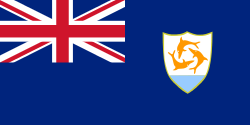
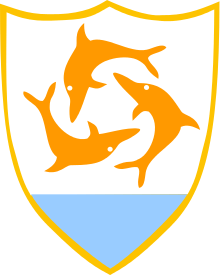


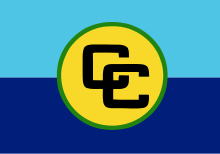
Countries.png)